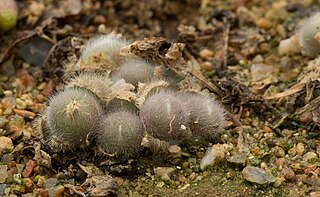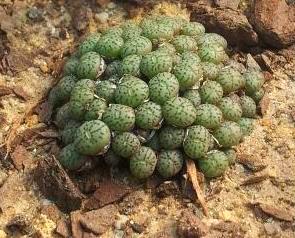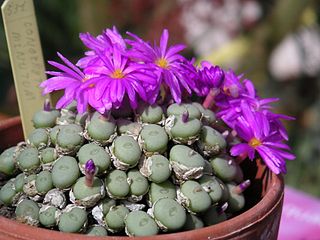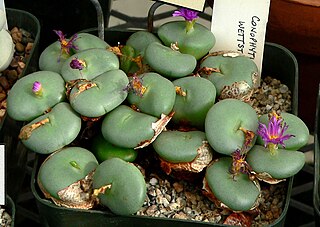
Conophytum is a genus of South African and Namibian succulent plants that belong to the family Aizoaceae. The name is derived from the Latin conus (cone) and Greek phytum (plant). The plants are also known as knopies, waterblasies, sphaeroids, conos, cone plants, dumplings, or button plants.

Conophytum jucundum is a species of succulent plants belonging to the family Aizoaceae. As its synonym Conophytum gratum, the pleasing cone plant, it has gained the Royal Horticultural Society's Award of Garden Merit.
Flavum is a Latin word meaning "yellow". It is often used in taxonomy for species names typically in scientific names for animals and plants to refer to the flower colour or other aspect of the species.

Conophytum stephanii is a small South African species of Conophytum succulents named after German plant collector Paul Stephan, who tended the succulent collection at the Hamburg Botanic Garden in Hamburg, Germany. The plant was first described by Dr. Schwantes in 1929 and published in "Die Gartenwelt" 33:25.

Conophytum calculus is a small South African species of succulent plant in the family Aizoaceae.

Conophytum burgeri is a small, endangered, South African species of succulent plant, of the genus Conophytum.

Conophytum breve is a small South African species of succulent plant of the genus Conophytum.

Conophytum flavum, the yellow cone plant, is a small South African species of succulent flowering plant of the family Aizoaceae.

Conophytum ficiforme is a small South African species of succulent plant of the genus Conophytum.

Conophytum truncatum is a small South African species of succulent plant of the genus Conophytum.

Conophytum piluliforme is a small South African species of succulent plant of the genus Conophytum.

Conophytum minimum is a small South African species of succulent plant of the genus Conophytum.

Conophytum bilobum is a plant in the family Aizoaceae, native to southern South Africa. It blooms in autumn. It is scentless and grows to a height of 7 cm (2.8 in). The specific epithet bilobum comes from the two-lobed bodies these plants possess.
Vlokia ater was the first species described for the genus Vlokia in the Aizoaceae plant family. The genus name honors the discoverer, South African botanist, Jan H. J. Vlok (1957-). The species name derives from the Latin adjective "ater" for "black" and refers to the black coloring which older leaf leaves assume.

Conophytum obcordellum is a species of flowering plant in the family Aizoaceae, native to the Western Cape of South Africa. It is a small clump-forming succulent, growing to 10 cm tall and 1 m broad, forming glossy grey pebble-shaped growths, heavily marked with dots and lines. Daisy-like, silky white or pink night-scented flowers are borne on mature plants in spring.

Conophytum minutum, called the lesser dumpling, is a species of flowering plant in the genus Conophytum, native to the western Cape Provinces of South Africa. It has gained the Royal Horticultural Society's Award of Garden Merit.

Conophytum pellucidum, called the transparent cone plant, is a species of flowering plant in the genus Conophytum, native to the western Cape Provinces of South Africa. It has gained the Royal Horticultural Society's Award of Garden Merit.

Conophytum wettsteinii is a species of flowering plant in the genus Conophytum, native to the northwest Cape Provinces of South Africa. It is known to grow in rocky regions, often nearby Crassula elegans. C. wettsteinii is a small groundcover species, which appears stemless with fused leaf-pairs having a obconical shape. This plant relies on winter rains and is mainly dormant in summer months. Best growth occurs when drainage is available, and when only shaded during mid-summer. Propegation can occur through seeds or through cuttings from a full grown plant, where each cutting contains at least 1 head and a fraction of root. It has gained the Royal Horticultural Society's Award of Garden Merit.
Conophytum chrisolum is a species of succulent plant in the family Aizoaceae. It is endemic to the Richtersveld region of Northern Cape Province in South Africa. It may be the smallest free-living, land dwelling (non-aquatic) flowering plant, and certainly is the smallest succulent, measuring no more than 0.4 inch (10 mm) in height by less than 0.25 inch (6 mm) in width. It never branches or divides. It was only discovered in 1994 by botanical explorer Chris Rodgerson. The solitary magenta colored flower, up to 0.8 inch (20 mm) in diameter, is wider than the plant.
Cheiridopsis umdausensis is a species of succulent plant from South Africa.

















